|
Monday, October 26, 2009
Progress Notes
One of the Miller County residents who has several generations of family descendents on both his maternal and paternal sides is Gary Carrender, originally of Eldon (photo 01).
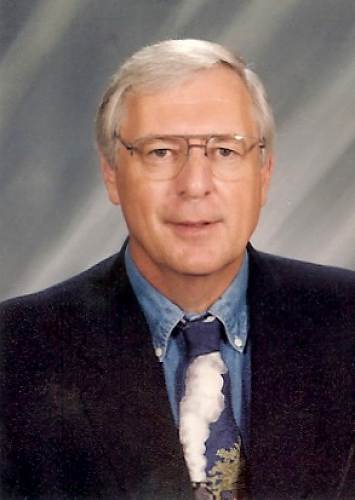
01 Gary Carrender Gary, who is an educator specializing in history, taught in the School of the Osage system for quite a few years and was principle there for ten years before retiring. However, he didn’t stay retired very long before he joined the staff of Columbia College of Osage Beach where he was appointed to the positions of Academic Advisor, AHE Teacher Education, and Program Coordinator. His wife, Donna Shockley Carrender, is a board member of our Miller County Historical Society. Gary’s family background includes the names of Brockman, Vernon, Taylor, McFall, Harrison, and Tomson. His parents, Roy Lee (Casey) and Francis Lucille Vernon Carrender (photo 02), had through the years saved many family artifacts and photographs which are of significant interest to those who enjoy knowing more about our county.
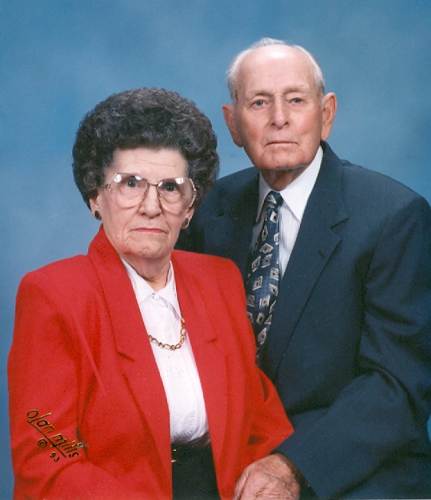
02 Frances Lucille Vernon and Roy Carrender The other day I went over to Gary and Donna’s home to learn more about the Carrender family, and especially to obtain some more information about the Rock Island Railroad, where Gary’s father, Roy “Casey” Carrender (photo 03), and grandfather, Charles Jasper Carrender (photo 04), spent most of their work career .
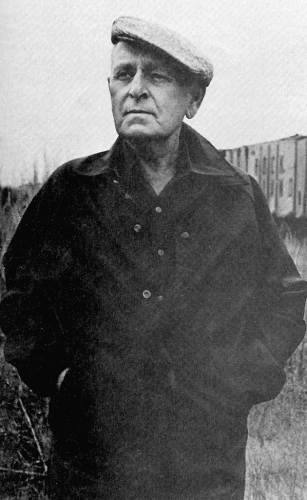
03 Roy "Casey" Carrender
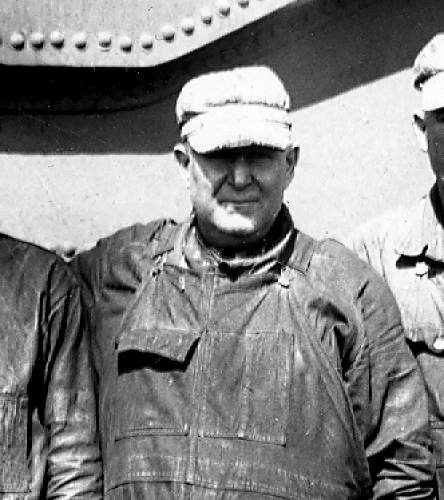
04 Charles Jasper Carrender Before reviewing the railroad history which Gary shared with me, I thought it would be interesting to view some photos of some of the interesting historical items Roy’s mother, Lucille, had collected through the years. Here is a photo of a powder flask (photo 05) which was owned by Benny Carrender. This would be a pre Civil War item I would think.
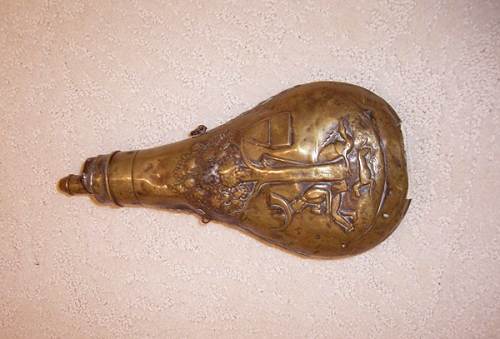
05 Benny Carrender's Powder Flask Another old heirloom is this fox horn (photo 06) owned by William G. Carrender, Gary’s great grandfather.
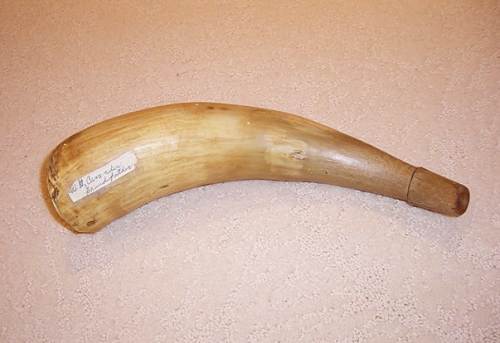
06 William G. Carrender's Fox Horn One of the oldest Carrender possessions is this dinner plate which came with the Carrender family from Germany (photo 07).
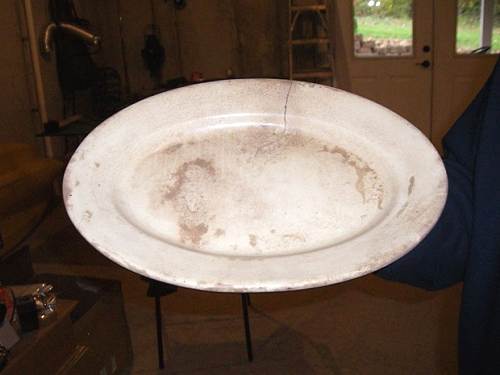
07 Carrender Plate came with family from Germany Here is Gary holding up a couple of lanterns used by his father, Roy, on the railroad (photos 08 and 09).
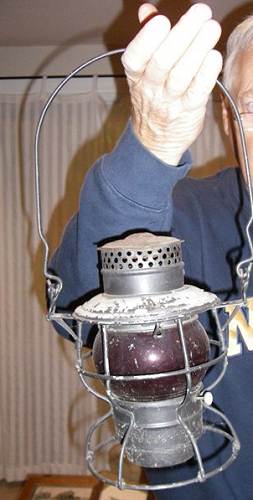
08 Oil Lantern
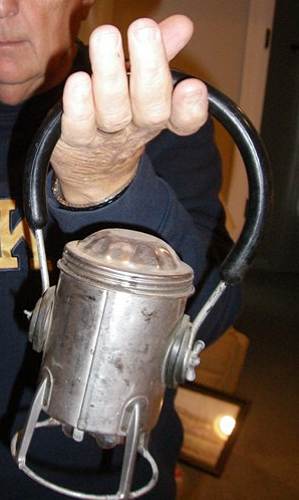
09 Battery Lantern And here are photos of Switch Keys and Time Tables used by Gary’s father, Roy (photos 10 and 11).

10 Railroad Switch Keys
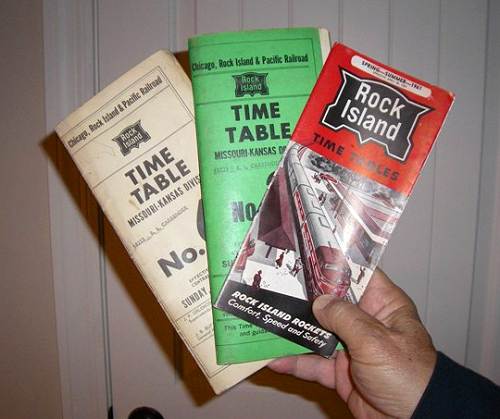
11 Rock Island Time Tables The first Carrenders for whom we have some history are George T. and William G. Carrender. George was the great great grandfather and William the great grandfather of Gary Carrender. Peggy Hake has written a biography of these antecedents of Gary which I have copied from our website:
WILLIAM GEORGE CARRENDER
William George Carrender was born in Miller County, near Mt. Pleasant, on May 3, 1862, a son of George W. Carrender (born c/1839) and his wife, Mary A._____. No record was found of their marriage in Miller County, but according to the 1860 census, they were newly-married. She was 17 years of age and George was 21. William was a grandson of Alfred and Elizabeth Carrender, early settlers of the county. They were in Miller County during the first county census, taken in 1840.
George W. and Mary A. Carrender became parents of three sons born between 1860 and 1865. The sons were James H. Carrender b. c/1861 m. Harriett Pinkston 1880; William George Carrender b. 1862 m. Sarah Leona Harrison 1881; and Joel J. Carrender b. c/1865 m. Henrietta/Nettie Heldstab 1885.
Sometime before August 1866, George W. Carrender died and there is the possibility he was a casualty of the Civil War. It was in August 1866 that his widow, Mary A. Carrender, married Robert R. Stansberry. They had a daughter, Minerva Lee, who was a half sister to James, William, and Joel Carrender. By 1870, Mary was once again alone with four children in her home---James 9 years old, William 8, Joel J. 5, and Minerva/Mary Lee age 1 month. Minerva married George W. Hicks in 1885 when very young. The census gave her name as Mary Lee Stansberry, but her marriage records give her name as Minerva Lee Carrender.
William George Carrender married Sarah Leona Harrison on August 14, 1881. She was a daughter of William T. Harrison (born in Kentucky) who was living in Equality Township in 1880. William and Sarah Leona became parents of seven children including Herbert O. Carrender b. Jan 1882 m._______; Oscar Eldridge Carrender b. Oct 1883 m. Emma Pauline Williams 1910; Charles J. Carrender b. Sep 1885 m. Nora Brockman 1907; Willard A. Carrender b. Oct 1887 m. Ida B.______; Lela M. Carrender b. Nov 1891; Annie J. Carrender b. Feb 1896; and Essie Carrender (born after 1900). I don't know if any of the three daughters married because they were still living at home when their father died in 1922.
William was a farmer and stockman of the Equality/Saline townships area for over 30 years. About a week before his death on March 7, 1922, William exchanged his farm with his youngest son, Willard, and took the son's residence in Eldon. William had become quite ill during the influenza plague that hit America in the era of 1918-20 and never fully recovered from the illness. He gave up farming to move to Eldon, but only lived for a short time after the move.
At his death he was survived by his wife, Leona; his seven children; 10 grandchildren; one brother, Joel Carrender of Eldon; his half-sister, Mrs. George Hicks of Eldon; and a half-brother, L. F. Russell of Algire, MO....(NOTE: I still haven't figured out who the half brother was). He was buried at Salem Cemetery, north of Eldon. His wife lived for 40 years after William's death and died on July 12, 1962. She was buried beside William at Salem Cemetery.
Thanks Peggy. Here is an old photo of the William G. Carrender family (photo 12):
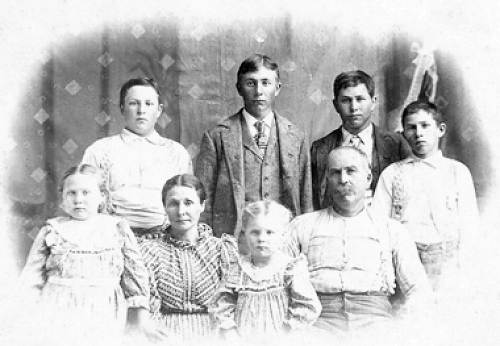
12 William George and Sarah Leona Harrison Carrender Family William’s wife, Sarah Leona Harrison Carrender, who was born in 1861, lived to be one hundred years old! This photo of her is of poor quality because it was scanned from the newspaper article on the occasion of her one hundredth birthday (photo 13).
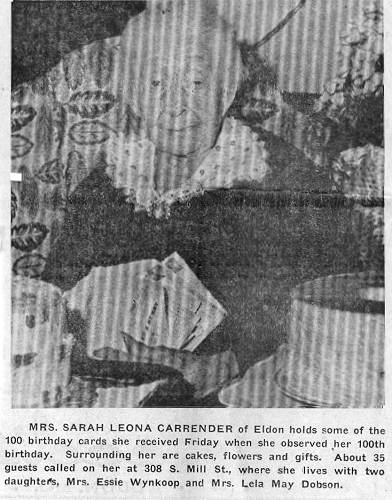
13 Sarah Leona Carrender - 100th Birthday
Click image for larger viewCopied below are some interesting comments she gave for this article, which were taken from the Eldon Advertiser in 1961, and a second Advertiser article written the same year around the time of Mother’s Day:
“Grandma Carrender” was born and reared on a farm four miles north of Tuscumbia. Her father, W.T. Harrison, was a farmer and stockman. She vividly recalls attending her first school which was located on the Little Saline Creek between her home and Tuscumbia. The log schoolhouse had one window and a floor hewed of logs.
Note: This was probably Ginger Ridge School since the school was so close to William Harrison’s farm (photo 14).
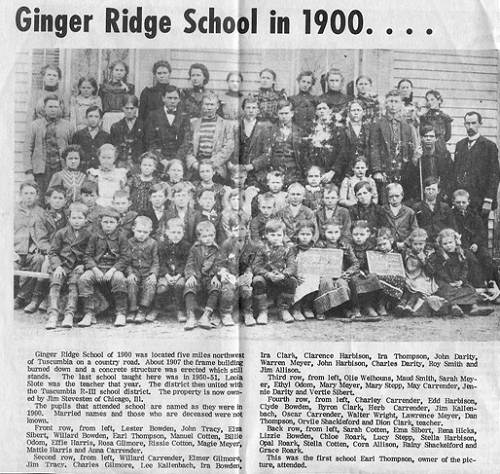
14 Ginger Ridge School - 1900
Click image for larger viewAs will be described below in the remainder of the article, soon after marrying William Carrender, Sarah and William sold their first farm near Eldon and bought eighty acres located on the farm of her father, William Harrison, five miles north of Tuscumbia. The Carrender farm was located in Section 29 of Township 41N Range 14 W. Here is a photo of the Township (photo 15):
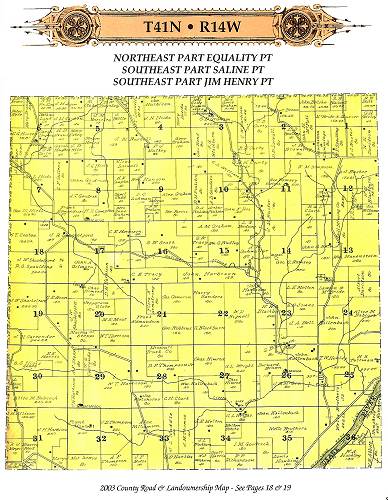
15 T41N - R14W
Click image for larger viewAnd here is a closeup of Section 29 (photo 16):
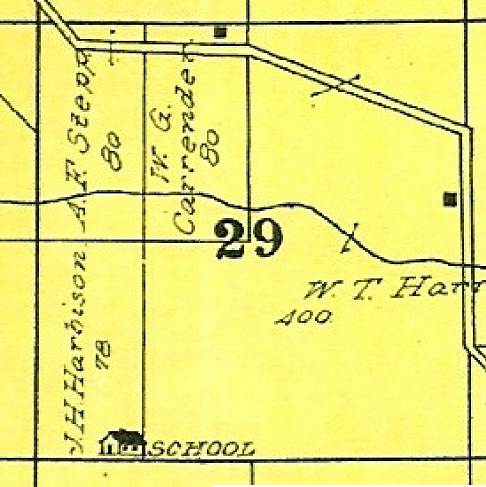
16 Section 29 You will notice that the William Carrender farm is located on eighty acres in the upper middle left of the Section and the William Harrison farm of four hundred acres where Sarah was raised adjacent and to the east. In the bottom left of the section you will see a school house icon which represents the location of the Ginger Ridge School. It was very close to the Carrender farm.
Now continuing with the article:
Motherly duties came early in life for Grandma Carrender. On her 16th birthday her mother died, so being the eldest of seven children, she gave a mother’s care to her brothers and sisters.
At the age of 19, she married William G. Carrender, a farmer, at California Missouri, and they started house keeping on the Saline Road near Eldon. Later, they bought 80 acres adjoining her father’s farm in the Little Saline Creek Valley five miles north of Tuscumbia. She recalls that in the spring she would take sheep wool to have carded into yarn at a carding mill at Wright’s Spring, then located on the old Green Lee Wright farm. The spring yet remains on the farm (photo 17).
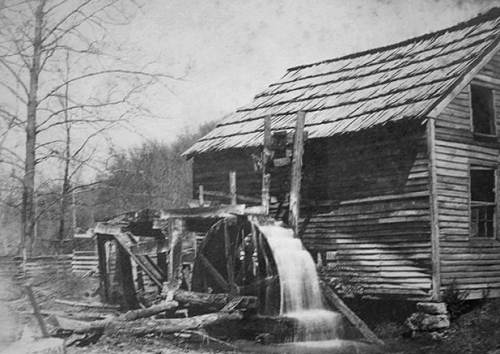
17 G.L. Wright's Carding Machine They lived there until Mr. Carrender died in 1922, except for a brief residence on the Wells farm east of Tuscumbia. Since 1922, she has lived with her daughter, Mrs. Essie Wynkoop on Mill Street, just north of Highway 54.
Although her Civil War memories have dimmed, she recalls hiding her father’s livestock in the woods where bushwhackers could not find them. She recalls when steamers delivered supplies to Tuscumbia stores and when blocks of ice were chopped from the Osage River, wrapped in cloth and preserved in sawdust. Her husband spent much time rafting ties on the river, and all her sons were employed on the steamer, J.R. Wells.
Grandma saw an automobile for the first time in 1909, but it left a poor impression. Julius Colton, a farmer west of Eldon, raced the Model T roadster past her house and drove through the middle of her turkey flock, leaving feathers flying in the air.
“I’ll keep driving old Mutt and Jeff,” she told her family, referring to their team of white horses.
Crocheting never appealed to her, but knitting became a favorite hobby. She knitted much of her family’s clothing and was constantly making sweaters, gloves and socks for others. She continued the work until five years ago.
She also was adept at barbering, giving haircuts to her four sons and other youths in the neighborhood. When her son, O. E. was 15 years old, she gave him his first lesson with the clippers, using another son, Charles, for the model. The barber chair was a walnut stump in the backyard, and her apron served as the hair cloth.
Grandma Carrender has always found a way to help the unfortunate. The sick were assured of her attention, when at night she used a lantern to find her way to their homes. Perhaps being left motherless herself was what prompted her to give a mother’s care to children whose mothers passed away. Often she would bring the youngsters into her home and teach them to cook and sew.
Mrs. Carrender has 13 grandchildren, 25 great grandchildren and 8 great great grandchildren. Her brother and two sisters were unable to visit her on her birthday. They are John Harrison, 93, and Mrs. Marvin Slote, 86, both of Eldon, and Mrs. Leo Williams, 91, of Palco, Kansas.
I asked Gary Carrender, great grandson of William and Sarah Carrender, how many children they had. He listed the following names:
Oscar Eldridge, Herbert Oliver, Willard A., Anna, May, Essie, and Charles Jasper.
Before proceeding with Gary’s direct ancestry to William and Sarah, I wanted to discuss one of Gary’s great uncles, Herbert Oliver Carrender, son of William and Sarah Carrender. His story was told me by his niece, Betty Carrender Klann (photo 18) now of the Kansas City area. Betty is the daughter of Willard Carrender, brother of Herbert.
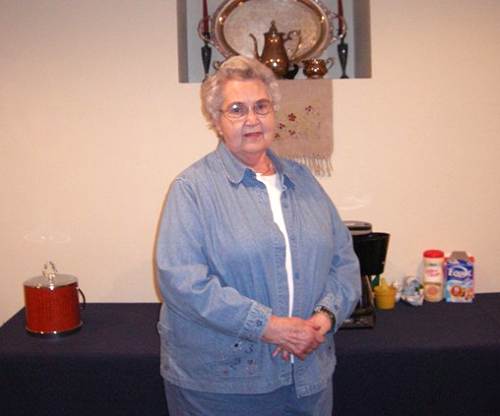
18 Betty Carrender Klann Her uncle Herb for a time had a barber shop in Tuscumbia although she is unsure of the year. He is pictured here standing in front of a building with a barber pole (photo 19).
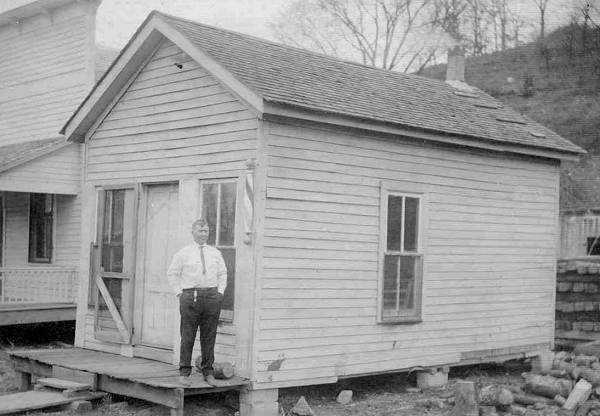
19 Herb Carrender's Barber Shop in Tuscumbia Interestingly, his barber shop was situated next to the building which was used later by most Tuscumbia barbers. Betty donated to our barber shop display at the museum Herb Carrender’s hair brush (photo 20).

20 Herb Carrender's Hair Brush A second photo donated by Betty is of her uncle Herb, third from left, with a team of mules along with five other teams on the Wells farm, probably before the turn of the century (photo 21).
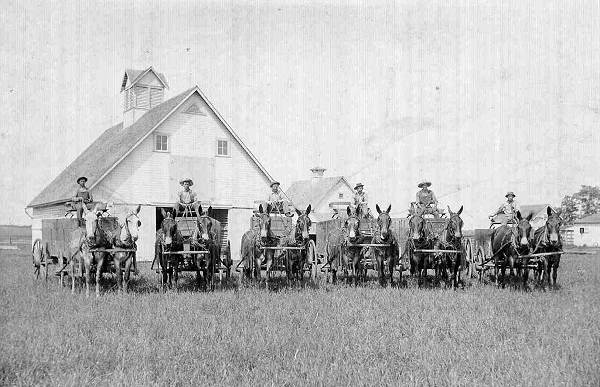
21 Herb Carrender - Third from Left on Wells Farm
Click image for larger viewBetty remembered coming to Tuscumbia occasionally with her father on a wagon drawn by a team of horses. They came from the Carrender farm located on the Little Saline creek which I identified above. She remembers the family attended the Little Saline Church of Christ. She also remembers Royal Kallenbach who lived nearby. She attended Ginger Ridge School as a child.
Betty was present the day of the McGowan brothers shooting in downtown Tuscumbia many years ago in 1933. She and her father, Willard, were riding the horse drawn wagon down the street to Madison Bear’s store when the shooting began. Her father quickly drove the team to the side of the store away from the shooting to protect the family. You can read about the McGowan brothers shooting, one of the most tragic stories of Tuscumbia history, on a previous edition of Progress Notes.
Scroll half way down the page to get to the narrative about the McGowans’.
Charles Jasper Carrender, son of William and Sarah Carrender, was Gary’s grandfather (see photo 04 above). Charles spent his early years as a child and adolescent on the farm to which his parents had moved earlier on the Little Saline Creek. He attended Ginger Ridge School (see photo 14 above). One of his grade cards which Gary possesses is dated December 6, 1895 (photo 22).
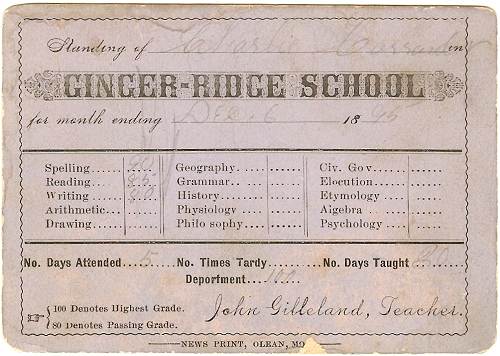
22 Charles Carrender Grade Card
Click image for larger viewYou will notice that of the twenty days school was in session, Charles only attended five. However, his grades were very acceptable! Reading, spelling and writing were the curriculum at the time.
On December 31, 1907, Charles married Nora Etta Brockman (photo 23).
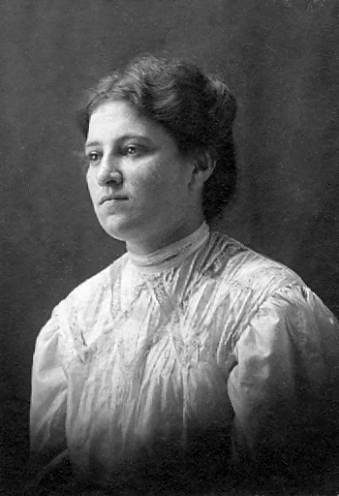
23 Nora Etta Brockman Carrender
Mother of Roy Lee "Casey" Carrender She was a daughter of John S. Brockman. Here is their marriage certificate (photo 24):
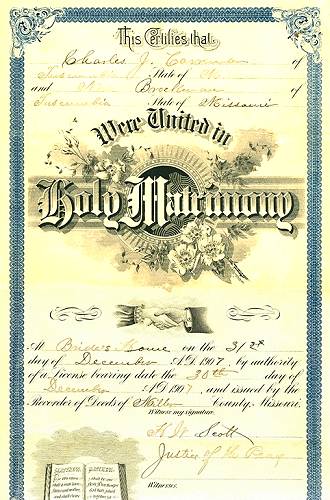
24 Charles Carrender and Nora Brockman Marriage Certificate
Click image for larger viewGary has a photo of the John S. Brockman family (photo 25).
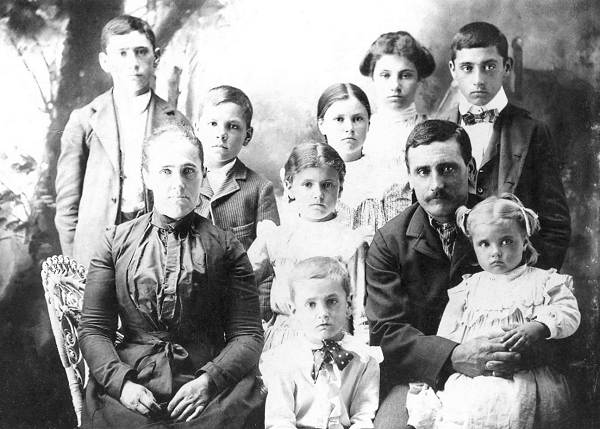
25 John S. Brockman Family Nora is in the number 9 position of the photo as depicted in this numbered diagram (photo 26).
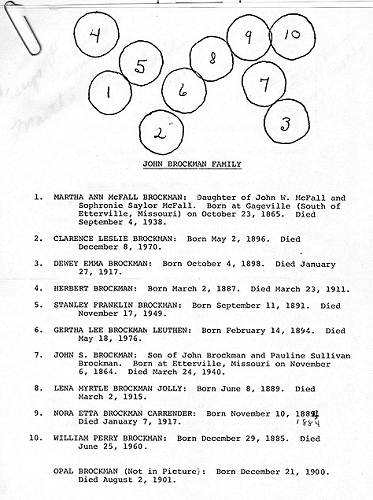
26 John S. Brockman Genealogy
Click image for larger viewEarly on, Charles joined the work force of the Rock Island Railroad working as a fireman and machinist helper. He and Nora settled down and began to raise their family of five children on the old home Carrender home place located in the Little Saline Creek valley (photo 27).
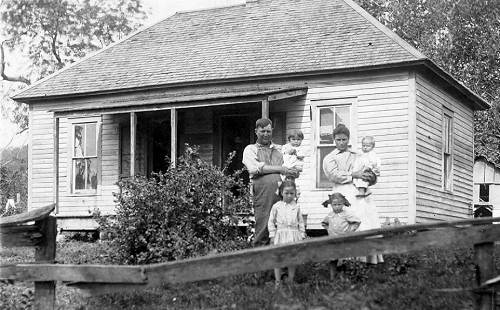
27 Charles Jasper and Nora Brockman Carrender Home on Little Saline One of their children, Roy “Casey” Carrender, was Gary’s father about whom more will be discussed later. Sadly, Nora died at the young age of 33 in 1917. The death of Nora was a tragic event for all Miller County. C.B. Wright of Tuscumbia wrote about it in his weekly Autogram column of January 7, 1917 (photo 28).
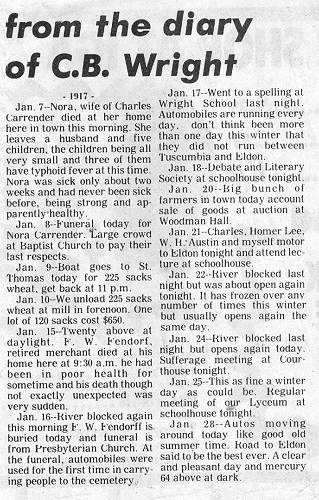
28 C.B. Wright Column
Click image for larger viewIn 1919 Charles married Gertie Vernon. Sometime after that Charles and his family moved to Eldon (photo 29).
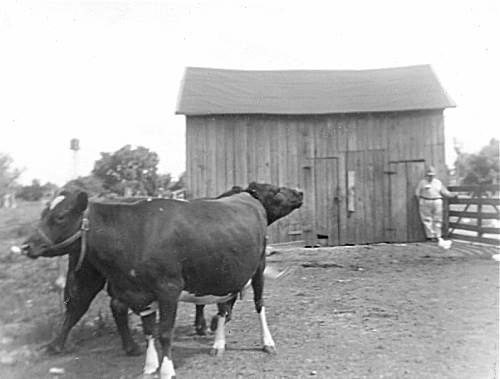
29 Charles J. Carrender - 2nd Home on Colorado Street in Eldon Charles was truly one of the early railroad pioneers in Eldon. He had many friends from his railroad days. Here is a photo of Charles with two of his railroad buddies (photo 30).
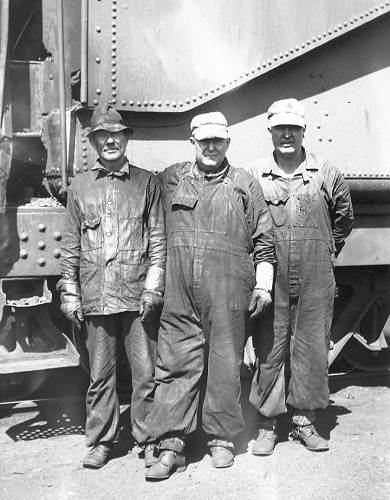
30 Bert Hays, Charles Jasper Carrender and Ab Strange Charles also was a member of the Modern Woodmen Fellowship and participated in their activities. In this photo he is sitting on the far right (photo 31).
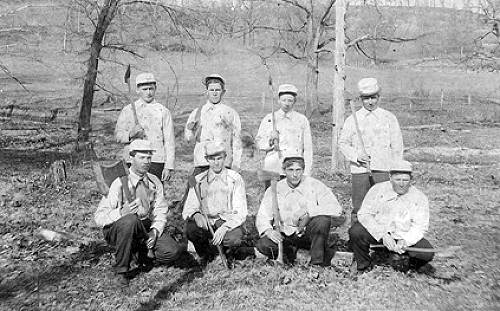
31 Modern Woodmen - On Right Sitting - Charles Jasper Carrender - Grandfather of Gary Roy “Casey” Carrender, son of Charles and father of Gary Carrender, grew up in Eldon. Early on he attended Aurora Springs School (photo 32).
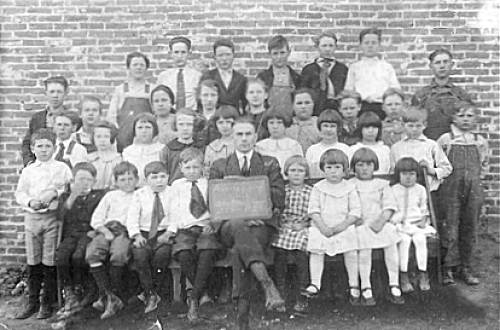
32 Aurora Springs School - 1922 - 1923
Casey is on the front row sitting next to teacher Glen Amos His first job was as a shoeshine boy working in a barber shop located south on Maple Street next to the railroad (photo 33).
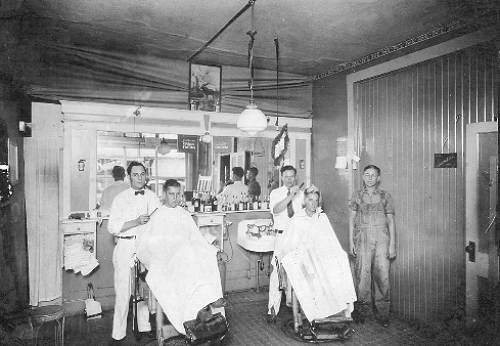
33 Jim Hanks and Bob Howser (Left)
Earl Allee and Harold Starks (Right)
Roy Carrender - Shoe Shine Boy (Standing) Later, he followed his father into the Rock Island organization working as a brakeman after returning home from military service during WWII. He was married to Lucille Vernon (photo 34).
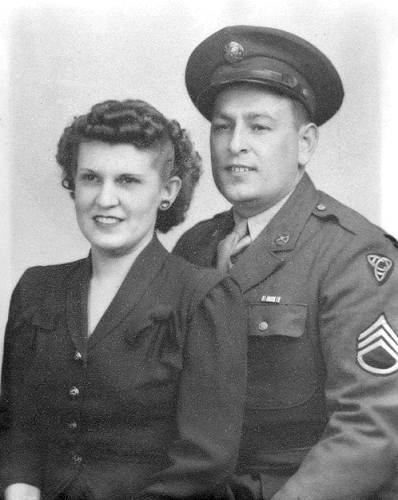
34 Frances Lucille Vernon and Roy Casey Carrender Roy always had the nickname “Casey” perhaps because he was such an avid railroader (referring to the song, “Casey Jones”), especially loyal to the Rock Island line. Roy’s friend, Roy F. Blackburn, supplied him with several railroad photographs which Gary gave me to copy. These are collaged here (photos 35 - 40):
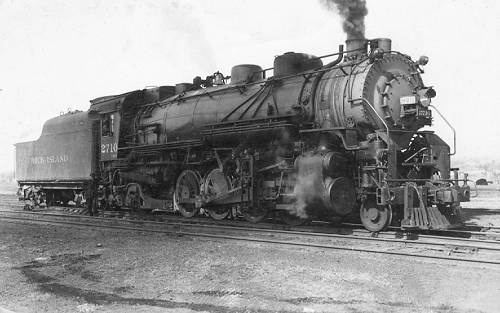
35 Rock Island Engine
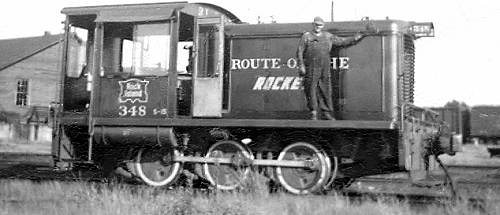
36 Rock Island Engine
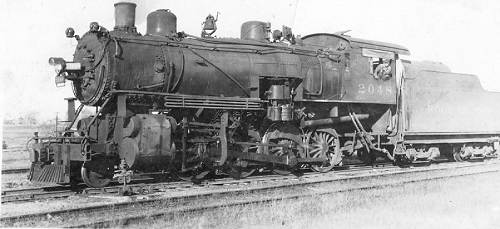
37 Rock Island Engine
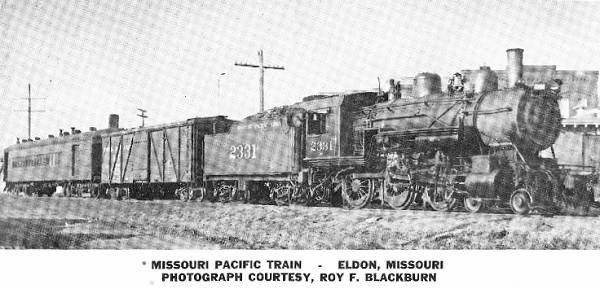
38 Missouri Pacific Train
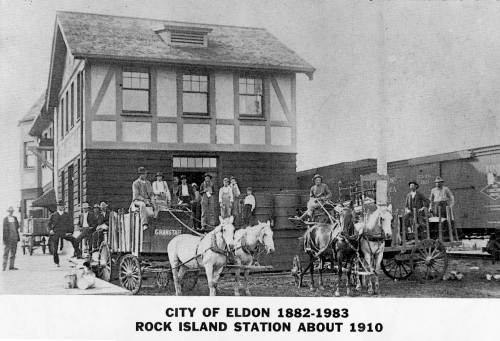
39 Rock Island Train Station
Click image for larger view
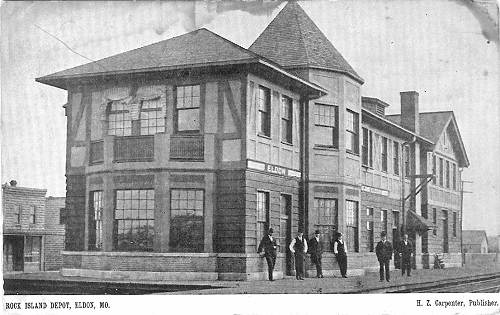
40 Rock Island Post Card (Front) - 1909
Click image for larger viewThe magnificent Rock Island train station in later years was demolished and replaced by this building, sketched by local artist Karen Strange (photo 41).
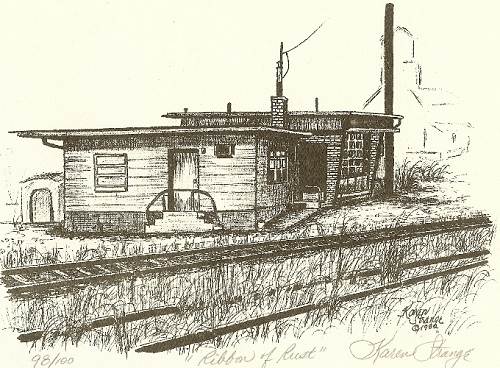
41 Second Rock Island Station It is titled “Ribbon of Rust,” a reference to the tragedy of the deterioration allowed to occur to the railroad line due to negligence by the company. This old building, which by the way still is standing, old, dirty and lonely, is a sad reminder of what once was one of the nation’s greatest railroads, “The Rock Island Line,” about which songs have been written and sung.
In 1982, Missouri Life Magazine published an article about the demise of the Rock Island Railroad in which the author, Mary Ann Gwinn, interviewed Gary’s father, Roy “Casey” Carrender (see photo 03 above). At the time of publication of the article the issue of closing the Rock Island was not settled. However, the management of the Rock Island had been ignoring, due to the expense, the maintenance of the track lines as shown in these two photos from the article (photos 42 and 43).
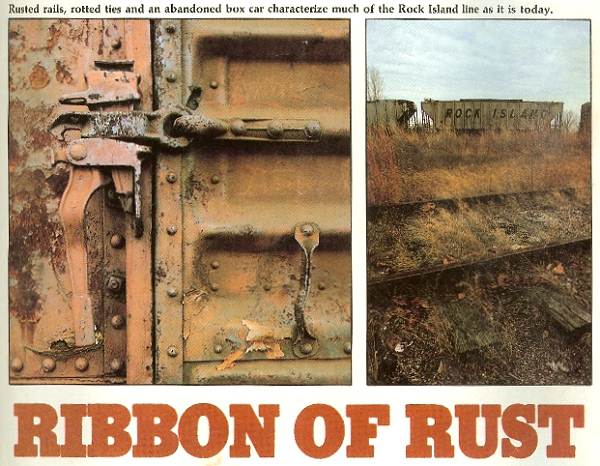
42 Ribbon of Rust
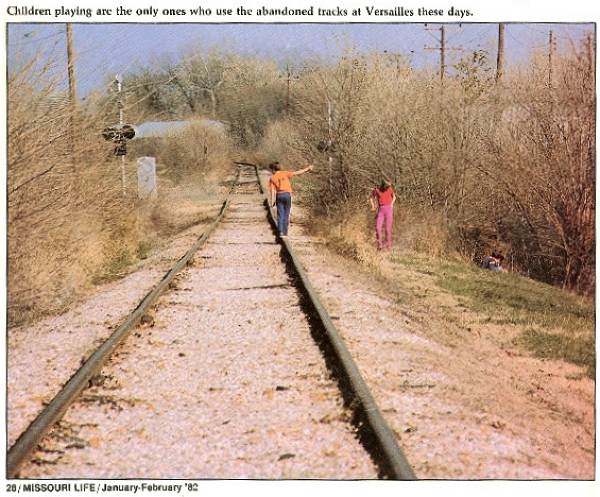
43 Ribbon of Rust The freight traffic significantly had been reduced such that shortly before the line closed all it was hauling was a clay product (photo 44).
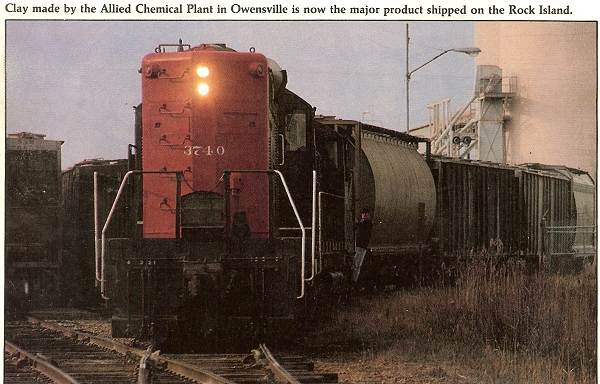
44 Rock Island hauling Clay Here is a copy of the cover page of that article (photo 45).
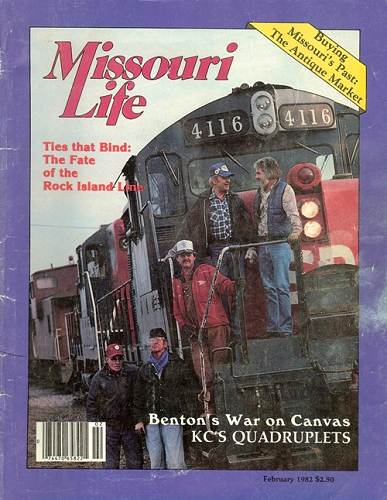
45 Missouri Life Magazine Cover And here is copied the article:
Ties That Blind
The Fate of the Rock Island Line
Mary Ann Gwinn
Published in MISSOURI LIFE/January-February 1982
Casey Carrender rode the Rock Island line in the days before the Route of the Rockets became the Ribbon of Rust. He’s retired now and lives with his wife Lucille, who once starched and ironed the overalls he wore as a brakeman on “The Rock’s” line between St. Louis and Kansas City.
Their modest brick home sits at the west end of Maple Street in Eldon. The east end of Maple dead ends into the “new” aquamarine Rock Island cinder block terminal, built after the railroad tore down its wooden two story mustard colored predecessor (see photo 41 above).
“Rock Island didn’t want to have to pay for a crossing,” Casey says, so where the terminal sits, so ends Maple Street.
Such are the woes of Eldon, once the Rock Island’s division point when it ran Pullman cars, World War II troop trains and locals along the route from St. Louis to Kansas City.
Eldon was some town in those days.
Norma Shearer, the movie star, stepped into the Eldon station once and took coffee in an Eldon eatery called the Beanery.
Eldon itself began when the Rock Island came through in 1903; the railroad giant bought up a small line called the St. Louis, Kansas City and Colorado Railroad to transport Missourians back and forth to the World’s Fair in St. Louis.
People moved whole houses up to Eldon from nearby Aurora Springs to be in the railroad town with its bustle and steady work. Casey’s father, a fireman and machinist helper, took his horse and buggy up from Aurora to stoke the steam engines. On cold mornings, Casey watched the steam and the sweat roll off his father’s shoulders when he shoveled coal into the “clinkers,” or coal burners.
“Until they started cutting back in 1932, there were five or six hundred men working on the line,” the former brakeman says. “That was the bread and butter for this town, and that’s been my bread and butter, all my life.”
If the Rock Island was Casey’s bread and butter, he was its eyes and ears.
West of Eldon, the line ran along Highway 52, through Versailles, Cole Camp, Chilhowee, into Raytown before it ended in the Kansas City switchyards.
Along the high flat land, nestled in a dark tunnel of trees, the elevated roadbed exposed for Casey farmhouses, grain silos, bales of hay and goat farms.
East of Eldon, the line ran over gravel bed streams lined with white sycamores and through groves of dark cedar. From the hazy hills that sheltered the old German communities…Argyle, Koelztown, Freeburg…the train roared into the Freeburg-Koelztown tunnel.
Note: here is a map of the Rock Island route (photo 47):
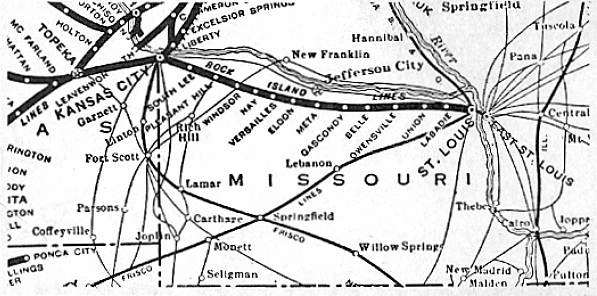
47 Rock Island Route “The steam, it was rough,” Casey says. The smoke coming in the train, held captive by the tunnel, “would like to choke you.”
The rail men dubbed an old couple who lived near the tracks “Gravel Gertie and B.O. Plenty…after the Dick Tracy comic strip characters. Gravel Gertie stepped up to the train once too often; she died under the Rock Island engine, standing right on the track.
The best things were the everyday things; going down the line, hunting for the deer and turkeys with his eyes only, not a gun. “You could see new things purt near every trip. And you had wonderful friends, like Jim Ingle.”
Jim Ingle rode the Rock Island for more than a decade with Casey; the brakeman’s warbled version of “O Christmas Tree” would send the engineer’s head out the window, no matter how cold the December air.
Ingle “came up from the Southern with a cement sack full of clothes and a wrinkle in his gut,” says Casey, when Ingle transferred to the Rock Island from the Southern Railroad in Kentucky in 1967.
Ingle still calls himself a “Rock Island Man,” but the ravages of a strike and long history of general neglect closed the line down in 1979.
Casey remembers the railroad for what it was, though most of his friends are dead now. Jim Ingle and his kind are the railroad’s future, if it has one.
“My grandfather and father before me was an engineer. It’s always been the railroad for us. I’m not sure that’s so smart, considering the situation,” Ingle says.
In the three years since Southern Pacific bought the line, Ingle has led a coalition that proposes to open up the Rock Island for rail serviced again.
Ingle belongs to the great fraternity of old railroad men. He shares membership with George Ross, a former Missouri Farmers Association employee who once worked for the Burlington Northern and then dealt with the Rock Island when it hauled MFA products in and out of communities like Eldon.
Ross and Ingle share a hope that the Rock Island can reopen, making the central Missouri communities along its route come alive again. Although Ingle works for the Southern Pacific now along the remaining open portion of the railroad, he dreams that the company will someday make good on a three year old promise.
That promise has gotten lost in the halls of the Interstate Commerce Commission, which opposes reopening the route. Southern Pacific itself prefers to forget its words to the coalition that it would resurrect the 300 mile route, as the cost of rehabilitating any railway spirals.
The odds are long.
“Don’t call us a dying breed, call us a dead breed,” says David Crane, a brakeman who works with Ingle on the only open section of the route…from Owensville to Olivette.
That pessimism masks a hope…that as long as there’s rail, there’s a railroad. Until they take up the track, they refuse to let the Rock Island die.
“In 1979, the Rock Island was so desperate they couldn’t even pay their fuel bills,” says Ingle. It was a bitter end for the railroad that has grown up with the Midwest.
“The Rock Island was one of the premier railroads in the country,” says Ross, “a Granger railroad” whose steam engines chugged and puffed through the rich agricultural land of Missouri, Iowa, Kansas and into the far West, out of its terminal in Rock Island, Illinois.
The agricultural heritage of “The Rock” was its undoing. The railroad concentrated on rural shipping and failed to establish toeholds in urban areas. It “always had to depend on other railroads to return cars to it,” Ross says. “There was not a large concentration of industries on its lines anywhere.”
Once, the railroads called the shots in America, carrying the country west on rails. In the era of the Robber Barons, that arrogance reached its extreme…there was no transportation competition to threaten the giants. William Vanderbilt (photo 48), son of Commodore Cornelius, summed it up in the 1890s when he delivered his most infamous utterance: “The public be damned.”
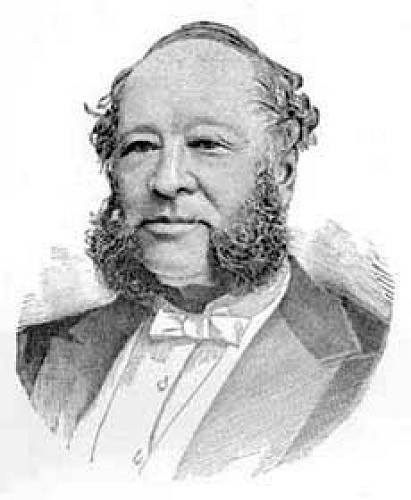
48 William Vanderbilt “If they wanted track line, they got it,” says Ingle. “They rode roughshod over a lot of homesteaders.”
The railroads inextricably wove themselves into the country’s very way of life; for example, our system of time zones was set up by the railroads to synchronize train arrival and departures.
The railroads’ excesses led to calls for governmental regulation. Regulation finally brought the ailing giant, the Rock Island, to its knees.
The Interstate Commerce Commission is anointed to approve railroad mergers. In the 1960’s it considered Union Pacific’s proposal to acquire the Rock Island.
It considered it to death.
George Ross worked for MFA then and represented the company as an interested party to the merger proposal. The company’s shippers depended on the Rock’s hopper cars to take grain to market and fertilizer back to the farmers.
“The hearings were held in Chicago,” Ross recalls. “I thought the evidence was strongly in favor of the merger.”
Other railroads, however, “didn’t want a strong company…they opposed it,” Ross says. “The judge suffered a broken leg. The hearings dragged on for years. The ICC was very much at fault.”
Says Ross: “Finally, the Union Pacific said, ‘We don’t want the Rock Island anymore.’ The route had deteriorated very severely.”
The route had earned its sardonic moniker: Ribbon of Rust. Track conditions had deteriorated so badly that what trains did roll did so at a maddeningly slow pace.
“You could only work 12 hours, and then they’d relieve you.” says Casey, who retired in 1978, the year before the Rock Island closed. A 10 mile an hour limit required by unsafe conditions on the deteriorating track forced Casey to put up for the night in a St. Louis hotel before he could return to Eldon.
“It used to be,” Casey says, “We could do Kansas City and back in a single day.”
In 1979 the Rock Island folded for good; its assets were placed under the care of a trustee.
Southern Pacific, under its subsidiary, Cotton Belt, proposed to buy the entire Rock Island line from Santa Rosa, New Mexico, to St. Louis. Their only other westward route, which looped down through Little Rock, Arkansas, into Texas and beyond to the West Coast, was longer by 400 miles that the St. Louis –Santa Rosa route.
“There was no public support’ for the Union Pacific- Rock Island merger”, and Ingle reasoned that was why it failed. He determined to get the public behind the Southern Pacific.
Southern Pacific was happy to accept the help.
“We wrote thousands of letters to shippers and the shippers in return wrote the ICC, Ingle says. “The town of Eldon bought stamps, envelopes, sent letters to different shippers along the line. They unanimously supported the Southern Pacific.”
Ross and Ingle both testified at the ICC hearings in Kansas City at what they way was Southern Pacific’s urging. “They came on very aggressively,” says Ross. “Several Southern Pacific officers visited us in Columbia…they said, ‘your time will be rewarded with good service once we acquire the line.”
Perhaps Ingle had a portent of what was to come when he met with the ICC bureaucrats.
“If you’ve ever been around some of these people and you realize your life is in their hands…”
“An ICC lawyer said we got more mail on this than any other merger in history, boxcars of ‘em.”
“ ‘Do you read them?’ I asked.”
“He said, ‘If it has a reasoned argument, we do.’ I said that if there weren’t emotion involved, we would never even have had a constitution.”
The merger was approved. Southern Pacific did rehabilitate the track…from Santa Rosa to Kansas City.
At the Department of Transportation’s urging, however, Southern Pacific declined to rehabilitate the Kansas City-St. Louis portion of the line. The department reasoned enough railroad lines existed between St. Louis and Kansas City and directed Southern Pacific to apply for “trackage rights” on either the Missouri Pacific or Burlington Northern routes.
Those tracks run at least 30 miles north of the Rock Island route. If trackage rights are granted, shippers who supported the acquisition will be left without rail service. As they do now, they will pay extra for truck transportation to the line.
Ross says advocates of the Missouri Rock Island line never had an inkling of the department’s objections until the final merger approval was handed down. Southern Pacific was only too happy to comply; however, times were rough in the rail industry.
Inflation for rail materials was running at 20 percent a year. Further, the ICC’s approval of Southern Pacific’s acquisition stated that “the Rock Island St. Louis-Kansas City segment is no longer essential for local shippers…”
Against all the evidence and testimony, the approval document stated “there is no evidence that local shippers require service on this line.”
The company estimated that rehabilitating the low density, agricultural line would cost at least $110 million and applied for trackage rights.
If the ICC grants Southern Pacific the right to run its trains on either track, the company will have no reason to reopen the Rock Island line.
For Eldon, Versailles and all the other communities that line the Route of the Rockets, any hope for rail service will dissolve like a cloud of steam on a cold winter morning.
The small businesses and farmers who once shipped on the Rock Island say they are slowly being strangled by the Southern Pacific’s refusal to reopen the line.
Although the company has “railbanked” the line…agreed to keep the track intact for 10 years…that waiting period may be too long for the rails and ties that already have fallen into disrepair.
For the shippers, it may drive a final wedge of distrust between them and the railroad.
Bill Raynor inherited his father’s business in Eldon: Osage Products, which manufactures cedar shavings, cedar stakes, animal bedding and any other product requiring the fragrant wood that grows ubiquitously in the Lake of the Ozarks area.
The company’s factory at Linn Creek burned in 1946. “The reason we moved to Eldon was because of the railroad,” Raynor says.
“Every bit of our product goes by railcar,” he says, primarily to the West Coast…as far away as Vancouver. Since the line closed, “We have to load people and the product in trucks, take them to Jefferson City to the MoPac line and unload them.”
“You are taking supervisors out of your manufacturing operation. It’s a damn nightmare, if you want to know the truth of it.”
An easygoing, portly man in a goatee who favors V neck sweaters and running shoes, Raynor is nevertheless in the habit of holding his hand to his forehead when he talks about the Rock Island.
The farmers in the area “are very, very upset. I can’t tell you how upset,” he says.
“This little community has been hurt like hell. You’ve got people moving away, it’s affected manufacturing. But the people who really will get hurt are the people who buy the final products. Part we’re absorbing right now, but sooner or later we’ll adjust the price.”
J. Everett Mitchell, Missouri’s director of railroads, estimates that Eldon’s unemployment rate will jump by 2 percent if the railroad shuts down for good.
“The rail industry has had a major change in philosophy,” says Raynor. “They’re not interested in Osage Product’s business, in MFA’s business. They’re interested in hauling coal at $1,500 or $2,000 per car for hundreds of miles.
“They don’t give a damn about us, and that is going to kill them.”
Says Mitchell: “The rail system in this country is like a big tree. Cut off too many branches and the trunk is going to die. Branch lines provide 40 percent of the business for railroads in this country. What other business could survive losing that?”
The question for the railroads may be: Can they survive at all?
The atmosphere is chilly in Washington toward the railroads these days. As little as two years ago, federal money was available for low interest rail rehabilitation loans to railroads. The Reagan administration, however, proposed eliminating the budget for rail rehabilitation altogether.
Congress later reduced the cut to about 50 percent, form $80 million to $40 million.
The ICC’s philosophy is that the railroads “should streamline the rail system to four or five railroads running north and south in the country, two or three east and west, and count on big trucks to pick up the slack,” says Ingle.
Rail enthusiasts contend that view is short sighted; given enough time, the country will revert to the rails as a more fuel efficient mode of transportation than big trucks.
“It takes four times the energy per ton to take a truck down the highway,” says Raynor.
The deck is stacked, they say, against the railroads: Billions of tax dollars go each year to maintain the highway system; the railroads must maintain they own right of way.
The shippers, too, must share some of the blame, says Ross.
“The shippers’ allegiance has wavered…if there were truckers in the area, and they needed money to come up with for repairs and so offered the shippers a cut rate, they would take it.”
An October 14 letter form Ben Biagini, the president of Southern Pacific, to Eighth District Congressman Wendell Bailey said Southern Pacific “contacted 37 industrial representatives in 20 different communities to ascertain their interest in rail service. The response was minimal.”
Jim Johnson of Southern Pacific’s Kansas City office points out that no one has come forth to offer to purchase the line…that, he says is sufficient evidence of lack of interest on the shippers’ part.
Ross says that may well be true, after years of slow, substandard service.
“The shippers and the railroads have not been talking to each other,” says Mitchell. “They’re going to have to now.”
Getting them together is like “a divorce court,” says Mitchell. “You’ve been together for a long time. Things are going downhill. When the railroad decides to abandon, the shipper is like the mate: ‘how could you do this to me?’ ”
Mitchell’s department faces the “ultimate challenge of getting the Missouri rail system moving again. He carries the air of an old time rail magnate, although his tiny department is almost lost in a sea of highway engineers in the mammoth state Department of Transportation.
He sports an 1890’s style mustache, favors vests and carries, as all good railroad men do, a railroad watch on a golden chain.
He pulls a cigarette from a silver scrolled case and punctuates his contentions with it.
He is strapped with a budget that currently totals less than $1 million, a drop in the bureaucratic bucket. But he has a tiny jewel of a success to his credit, notably the Illinois Central Gulf line from Mexico to Fulton.
“The line has been listed as a candidate for abandonment and the shippers in the Fulton area didn’t have any alternative,” he says. To upgrade the line, the federal government paid $1.086 million; the railroad chipped in $158,000 and the shippers contributed abut $112,000 to get the trains going again.
The result is an efficient, 25 mile an hour track that “proposes to reap $10.8 million in benefits over a period of 15 years in the Mexico Fulton area,” Mitchell says.
Other states have taken the lead in rail rehabilitation. For example, Iowa is in the process of creating a $300 million “pool” of money to rehabilitate its rails through a railroad fuel tax and bond issues.
“Agriculture is so important there,” says Ross. Iowa farmers are completely dependent on the rails to get their products to barge and port.
Mitchell, a former philosophy professor, jokes that his “Nietzschean pessimism” may stand him in good stead for slaying his biggest dragon: pleading the state’s case before the ICC to deny trackage rights to Southern Pacific, so that the state can force the railroad’s hand.
The governor’s office, the state Council on Economic Development and Bailey’s office are assisting him. The call to judgment on the Rock Island will occur within a year: Dwayne Benton of Bailey’s office says the ICC will make a decision on trackage rights for the Norfolk and Western by April 28 of this year. The ICC says it will rule on the MoPac application by December.
Railroad men have a certain style, a confidence dating from the days when they ran huge machines that could be grasped lifted, coupled and controlled.
Jim Ingle wears a red bandanna in his rear pocket. “A railroad man always has something red hanging out of his pocket,” he says. “Like the caboose…you can always tell he’s gone by.”
On a crisp winter morning in Owensville, he and his crew can be found doing all they ever wanted to do.
“We’re paid by the Cotton Belt, but we’re still Rock Island men,” says David Crane.
The sleek red and gray diesel backs up to the Allied Chemical Plant near Owensville, a plant that refines a pink gray clay used for water purification. The steam from the pastel plant wafts into the pearl gray sky.
Even if it’s Sunday, and even if the train will take 12 hours to get from Owensville to St. Louis, it’s a fine morning to be alive and on the line.
West of Owensville, however, the dull gray of the rails turns dull red, all the way through Eldon and beyond.
Casey Carrender has that certain style, too, with a red Rock Island belt buckle and a motoring cap perched jauntily on his head.
He walks the razed railroad yard at Eldon, where the turntable once pointed trains east and west. At the wash house, now leveled, he and his crew once washed up, punched in and out and went home to Lucille’s fine cooking and starched and ironed overalls.
The Eldon track is a graveyard. Rock Island hopper and freight cars stand gouged, twisted and bleeding with rust from the joints.
“This was the oil track, where we fueled up,” he says. “Now the ties are gone, the ballast (or road foundation)….gone.”
The only sound now on the wind where the trains once roared through is the chirp of a wayward sparrow. The yard is a palette of autumn tones: red rust, tall grass of burnt sienna.
For Casey Carrender, J. Everett Mitchell, George Ross and Jim Ingle, the yard and its promise is the object of their passion. They won’t let it go.
“I’ve got a cautious optimism,” says Mitchell, that the rails will revive.
“The worm may turn,” says George Ross.
Casey Carrender kicks a pebble and looks toward Eldon.
“Those trains may yet come through,” he says. “Wouldn’t that be fine?”
Published in MISSOURI LIFE/January-February 1982
Now you know why the Rock Island closed down. I had never known all the details given so thoroughly as the Missouri Life article provided when published back in 1982. Thanks to Gary Carrender and his family for saving it all these years for us to read!
For a complete summary of the early history of Miller County railroads refer to this previous edition of Progress Notes.
That concludes the story about the Carrender family of Miller County. I am very grateful to Gary Carrender for being my historian for the article. Gary, in turn, tells me to be especially grateful to his mother, Lucille Vernon Carrender, for being the one who saved all the articles, photos, and remembered so much to pass on to Gary. We at the museum are very grateful ourselves to Gary’s parents, “Casey” and Lucille Carrender, in whose name were given the many historical items about their family, Miller County, and the Rock Island Railroad.
That’s all for this week.
 Joe Pryor
|



